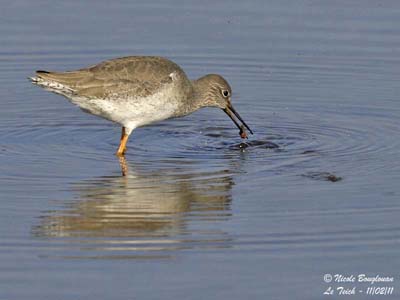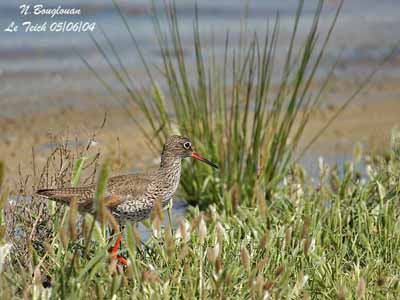
Common Redshank
Tringa totanus
Charadriiforme Order – Scolopacidae Family
BIOMETRICS:
Length: 27-29 cm
Wingspan: 59-66 cm
Weight: 85-155 g
DESCRIPTION:
Elegant shorebird with nice plumage, the Common Redshank is often seen near water and mudflats where it finds its preferred food items.

Adult in breeding plumage has grey-brown upperparts, spotted darker brown and black. On the upperwing, the secondary flight feathers are white, more visible in flight. The tail is white and finely barred black. Rump and lower back are white, conspicuous in flight.
Underparts are whitish, heavily streaked and spotted dark brown on breast, flanks and belly. Underwing is white with grey-brown primaries.
Head is brown, streaked and spotted dark brown, except on the white chin. The long bill is straight and slightly conical, with red base and black tip. Eyes are dark brown with white eyelid. Legs and feet are bright red.
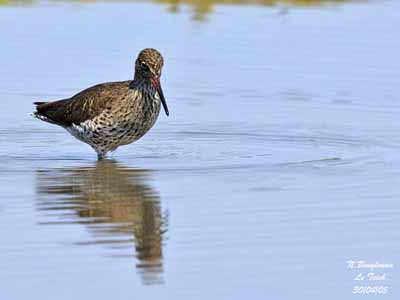
Both adults are similar, but female has paler upperparts than male.
In non-breeding plumage, upperparts are greyer without markings, except some narrow whitish fringes.
Underparts are paler too with fine streaks and grey-brown wash on breast. Flanks and undertail coverts are finely streaked dark.
On the head, we can see a white eye-ring. The bill is duller at base. Legs and feet are pale orange.

Juvenile has brown upperparts with buff-edged feathers and dense buff spotting and streaking. Underparts are white, heavily streaked dark brown.
The bill is duller, rather dark grey with dull red-brown base. Legs are pale orange-yellow.
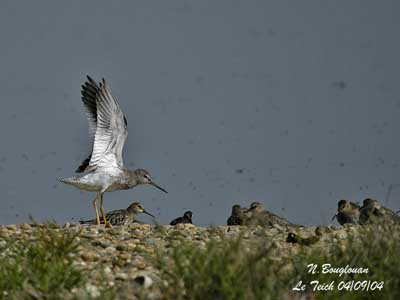
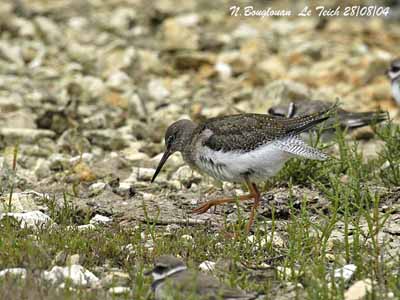
We find 6 subspecies. Races vary in some details of plumage and size.
There are robusta, totanus, ussuriensis, terrignotae, craggi and eurhinus, races robusta and issuriensis show more cinnamon in plumage and robusta is larger.
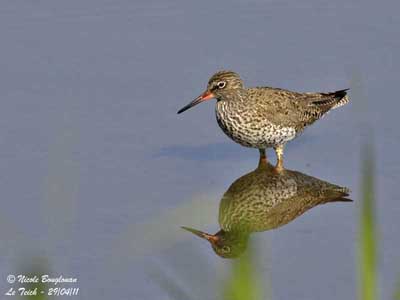
VOICE: SOUNDS BY XENO-CANTO
The Common Redshank is a noisy bird and when they are feeding in mixed flocks, they often are the first to give alarm calls such as long, mournful “tyuuuu”. This bird has wide repertoire of calls. The typical call given in flight is “teu-hu-hu” with longer and more accented first syllable.
We can also hear a creaking “taillouuuu” and a loud, rapid “tiu-biubiu-tillou”. These calls are given more rapidly when the bird is alarmed.
The song is a repeated “tyooo” uttered during the flight displays. This song becomes more accelerated when the bird is alighting “tiuliu-tiuliu-tiuliu”.
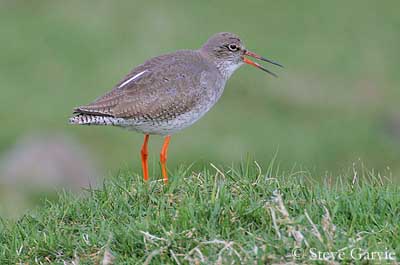
HABITAT:
The Common Redshank frequents coastal and inland wetlands such as coastal salt-marshes, grassy marshes, swampy areas and inland wet grasslands.
After the breeding season, it can be seen mainly in coastal areas such as rocky, muddy or sandy shorelines, open mudflats, salt waters or freshwater lagoons… It frequents sometimes inland waters and flooded grasslands.

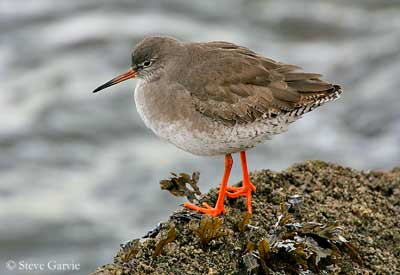
RANGE:
The Common Redshank breeds across temperate Eurasia and winters southwards on Mediterranean coasts, Atlantic European coasts and Tropical Africa, and in Southern Asia.
The different races share the wide range:
« Totanus » occurs in Ireland to W USSR.
« Ussuriensis » occurs in E USSR, Mongolia and N Manchuria.
« Terrignotae » occurs in E China.
« Robusta » occurs in Iceland, Faeroes and probably Scotland.
« Craggi » occurs in NW China.
« Eurhinus » occurs in N India and C and S Tibet.
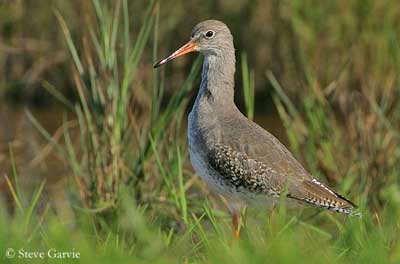
BEHAVIOUR :
The Common Redshank feeds mainly on insects, spiders and worms. Outside the breeding season, the bird feeds on molluscs and crustaceans, but also on small fish and tadpoles. Its feeding behaviour depends on the season. It walks along rocky, sandy and muddy shores, while pecking regularly, occasionally probing but rarely and also jabbing and sweeping through the water with the bill. This species is often seen wading, but it occasionally may swim.
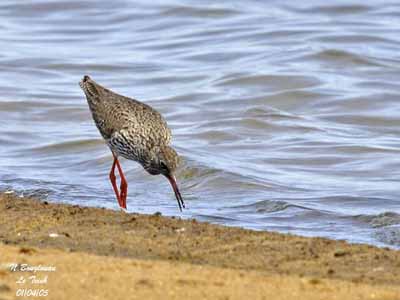
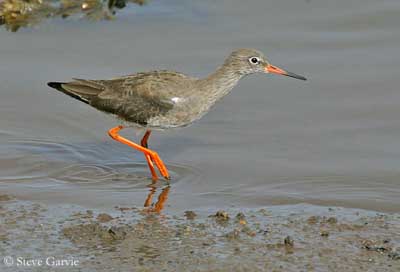
The Common Redshank forages in dense mixed flocks, sometimes up to 100 birds. They move in erratic way while pecking at preys, they run all at the same time in one direction, or sweep through the water with their bill. But it also feeds alone and defends its feeding area.
It forages in flocks for better protection and safety, mainly in open areas. They roost together in large flocks, often mixed species flocks.
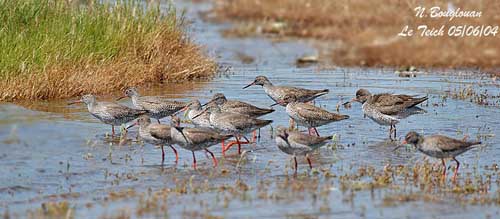
During the breeding season, the male performs courtship displays, and mainly flight displays during which it rises and falls in song flight with vibrating wings held downwards, below horizontal level. During these aerial displays, it also glides on stiff wings with jerky wing-beats. It also exposes the white underwing when on the ground.
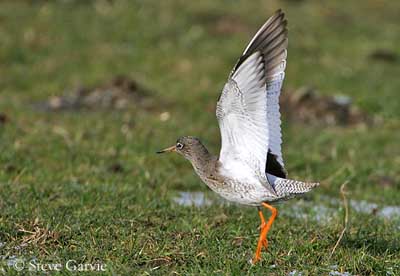
The Common Redshank is wary and nervous, and gives noisy alarm calls when in flocks if threatened. It constantly bobs its tail when alarmed or disturbed.
This species is migratory, with some birds virtually resident in Iceland and W Europe. They move southwards in winter and usually migrate at night. The predation by raptors is very heavy on wintering areas.
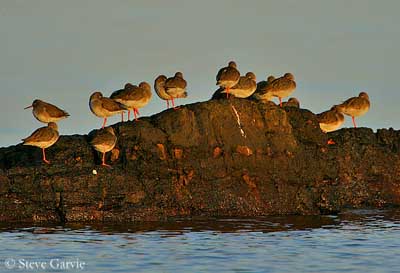
FLIGHT:
The Common Redshank in flight has conspicuous white rump and secondary flight feathers. The white “V” on back is distinctive.
It performs swift direct flight with steady wing-beats.
During the flight displays, the bird utters song which echoes nicely over the marshy areas.
REPRODUCTION:
Breeding season occurs in spring, with laying in April-June.
The Common Redshank is monogamous. It nests solitary or in loose colonies, either on coasts with up to 100-300 pairs/km2, or inland with only 10 pairs/km2.
The nest is a shallow depression on the ground, placed at base of tall clump of grass, with grass stems or leaves forming a roof. The base of the nest is built by the male, whereas the female lines the interior with twigs and leaves.
Female lays 3-5 whitish eggs with brown markings. Incubation by both adults lasts about 23-24 days. Chicks have cryptic colours with creamy or greyish-buff upperparts with dark streaks, washed buff breast and whitish underparts. The chicks disperse from the nest and feed themselves about 24 hours after hatching, but parents still tend and watch them. They fledge 23-25 days after hatching.
If the clutch is lost, female lays a replacement brood. She leaves the territory first while the male remains with the young until they fledge.
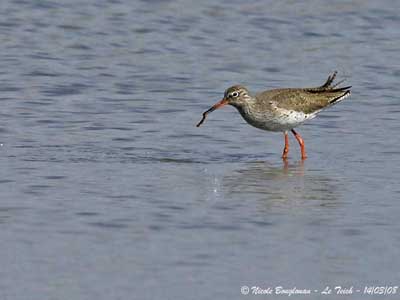
PROTECTION / THREATS / STATUS:
The Common Redshank is threatened by habitat loss, with drainage of inland wetlands. The breeding grounds are little by little converted for agriculture, human developments and other disturbances.
However, this species is not threatened at this moment, in spite of some declines of W Palaearctic breeding populations since the 1970s.
Predation by raptors in wintering areas is high, and only about 10% of the birds survive throughout the winter.
Fr: Chevalier gambette
All : Rotschenke
Esp : Archibebe Común
Ital : Pettegola
Nd: Tureluur
Sd: Rödbena
Photographers:
Steve Garvie
RAINBIRDER Photo galleries
Nicole Bouglouan
PHOTOGRAPHIC RAMBLE
Sources:
HANDBOOK OF THE BIRDS OF THE WORLD Volume 3 by Josep del Hoyo-Andrew Elliott-Jordi Sargatal - Lynx Edicions - ISBN : 8487334202
THE HANDBOOK OF BIRD IDENTIFICATION FOR EUROPE AND THE WESTERN PALEARCTIC by Mark Beaman, Steve Madge - C.Helm - ISBN: 0713639601
THE COMPLETE BOOK OF BRITISH BIRDS – Written by “Royal Society for the Protection of Birds” experts - Préface de Magnus Magnusson - Michael Cady- Rob Hume Editors - ISBN: 0749509112
SHOREBIRDS by Peter Hayman, John Marchant and Tony Prater – Christopher Helm – 1986 – ISBN: 0747014035
ENCYCLOPEDIE DES OISEAUX DE FRANCE ET D’EUROPE – de Peter Hayman et Rob Hume - Flammarion – ISBN : 2082009920
Birds of Britain - The Web Magazine for Birdwatchers
What Bird-The ultimate Bird Guide (Mitchell Waite)
